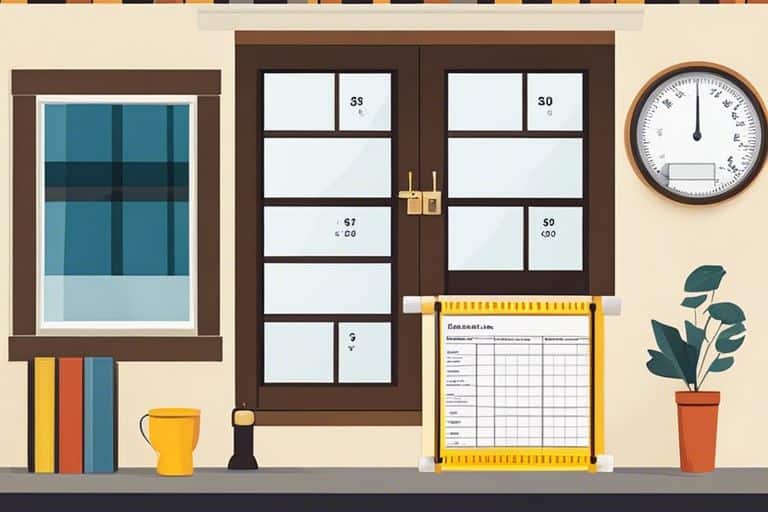Obtaining accurate measurements is crucial when considering replacement windows for your home. Incorrect measurements can lead to ill-fitting windows, resulting in drafts, leaks, and reduced energy efficiency. In this comprehensive guide, we will take you through the step-by-step process of measuring your windows to ensure a perfect fit for replacement. By following these instructions carefully, you can avoid costly mistakes and achieve optimal results when replacing your windows. Whether you’re planning a DIY project or seeking professional assistance, having the correct measurements is the first crucial step towards a successful window replacement.
Key Takeaways:
- Accurate measurements are crucial for a successful window replacement project.
- Measure width, height, and depth of the window frame to ensure the new window fits perfectly.
- Use a steel tape measure for precise measurements, avoiding fabric or plastic ones.
- Take multiple measurements of each dimension to ensure accuracy and avoid mistakes.
- Consult a professional if you feel unsure about measuring your windows for replacement.

Understanding Window Types
When it comes to measuring your windows for replacement, it’s important to understand the different window types that are available. Different types of windows require different measurement techniques, so knowing the differences between them is crucial.
- Single and Double-Hung Windows
- Casement and Awning Windows
- Sliding and Bay Windows
- Picture Windows
- Specialty Windows
For a comprehensive guide on understanding different window types and how to measure for replacement windows, visit How To Measure For Replacement Windows (2024).
Single and Double-Hung Windows
Single-hung windows have a fixed top sash and a movable bottom sash, while double-hung windows allow both the top and bottom sashes to move. When measuring for single or double-hung windows, it’s essential to take accurate measurements of the window frame and the width of the opening.
Casement and Awning Windows
Casement windows are hinged at the side and open outward, while awning windows are hinged at the top and open outward. Measuring for these window types involves taking precise measurements of the width, height, and depth of the window frame to ensure a proper fit for the replacement windows.
When measuring for casement or awning windows, it’s important to pay attention to any obstructions that may affect the operation of the new windows. After measuring, consider the How To Measure For Replacement Windows (2024) guide for additional tips.
Sliding and Bay Windows
Sliding windows feature one fixed sash and one sliding sash, while bay windows consist of three or more windows that angle out beyond the exterior wall. Measuring for sliding and bay windows requires accurate measurements of the width, height, and depth of the window frame, as well as the space needed for the sliding mechanism.
When measuring for sliding or bay windows, it’s crucial to ensure that the new windows will fit seamlessly into the existing space without any issues. For more detailed information, refer to the How To Measure For Replacement Windows (2024) guide.

Factors to Consider Before Measuring
Before you start measuring your windows for replacement, there are several factors you need to consider. Failing to take these into account can lead to inaccurate measurements and potentially costly errors.
- Window Age and Condition
- Structural and Framing Considerations
- Operational requirements
- Energy efficiency concerns
Any oversight in considering these factors can impact the fit and performance of your replacement windows, so it’s essential to thoroughly assess each element before proceeding.
Window Age and Condition
Before measuring for replacement, assess the age and condition of your current windows. It’s important to know whether age-related degradation or structural damage is affecting their performance. Cracked frames, deteriorated seals, or foggy glass are signs of wear and tear that can affect your measurements.
Structural and Framing Considerations
Structural and framing considerations play a crucial role in determining the measurements for replacement windows. Evaluate the integrity of the window frame, the presence of any rot or termite damage, and the levelness of the opening. Any inconsistencies in the framing can lead to fitting issues with new windows.
It’s also important to note the type of framing material and its compatibility with the new windows, as this can impact installation and long-term performance.

Step-by-Step Measuring Guide
In this chapter, we will walk you through the process of measuring your windows for replacement. It is important to take accurate measurements to ensure the new windows fit perfectly, so follow these steps carefully.
Tools Required for Measuring
Before you begin, ensure you have the essential tools for measuring your windows. You will need a tape measure, pencil, and notepad to record your measurements accurately. Additionally, having a step ladder on hand may be necessary for accessing windows that are higher up.
For precise measurements, it is important to use a metal tape measure rather than a cloth one, as it will provide a more accurate reading. When recording your measurements, avoid using a pen as it may lead to mistakes. Thou should always use a pencil to ensure easy corrections if needed.
Tips for Precise Measurements
When measuring your windows, take the time to double-check each measurement to avoid any errors. If possible, have a second person assist you to ensure the accuracy of your measurements. Remember, even the slightest error could lead to the wrong-sized windows being installed.
Furthermore, consider all aspects of the window, including the frame, when taking measurements. Measure from the inside of the frame to the inside of the frame, and from the outside of the frame to the outside of the frame, as this can affect the size of the replacement window. Thou should also take note of any obstructions, such as handles or locks, that could impact the fit of the new window.
Step-by-Step Instructions
Now, let’s move on to the step-by-step instructions for measuring your windows. Refer to the table below for a clear breakdown of each step, highlighting what needs to be measured and how to do so accurately.
It is crucial to measure each window individually, as even windows that appear to be the same size may have slight variations. This will ensure that the replacement windows fit perfectly and do not require any adjustments upon installation.
Recording and Cross-Checking Measurements
Once you have completed your measurements, it is important to record them accurately. Use the table provided to document the measurements for each window, and cross-check them to identify any discrepancies or errors. This will help to avoid any mistakes when ordering or installing the new windows.
Evaluating Replacement Options
When it comes to replacing your windows, there are several options to consider. Evaluating these options is crucial in ensuring you choose the best replacement windows for your home. In this chapter, we will discuss the pros and cons of different window types and provide tips for choosing the right replacement windows.
Pros and Cons of Different Window Types
When evaluating replacement options, it’s important to consider the pros and cons of different window types. Below is a breakdown of the advantages and disadvantages of popular window options:
| Window Type | Pros and Cons |
| Double-Hung | Easy to clean | Limited ventilation |
| Casement | Excellent ventilation | Limited design options |
| Bay or Bow | Expansive outdoor views | Higher cost |
| Picture | Unobstructed view | Limited ventilation |
| Awning | Great for ventilation | Limited design options |
Tips for Choosing the Right Replacement Windows
When selecting replacement windows, consider your specific needs and preferences. Energy efficiency and durability should be top priorities. Additionally, make sure to measure your windows accurately to ensure a perfect fit. The style and design of the windows should complement your home’s architecture. The type of material used for the frames is also an important consideration. The overall cost of the replacement windows should be within your budget.
When choosing the right replacement windows, it’s essential to research different suppliers and request multiple quotes to compare.
- Energy efficiency
- Durability
- Style and design
- Type of material
- Cost
The final decision should be based on finding the perfect balance of these factors while ensuring the long-term benefits for your home. The expertise of a professional window installer can also be invaluable in making the right choice.
Step-by-Step Guide to Measuring Your Windows for Replacement
In conclusion, accurately measuring your windows for replacement is an essential step in the process of upgrading your home. By following a step-by-step guide, you can ensure that your new windows will fit perfectly and provide optimal energy efficiency and aesthetic appeal. It is crucial to take the time to measure each window accurately and to follow the guidelines provided by reputable manufacturers such as Pella. For more detailed information and visual aids, you can refer to Pella’s comprehensive guide on ‘How to Measure for Replacement Windows’ here. By taking the time to measure your windows correctly, you can ensure that your replacement windows will enhance the comfort, beauty, and value of your home for years to come.
FAQ
Q: Why is it important to measure windows for replacement?
A: Measuring your windows accurately is crucial to ensuring a proper fit for replacement windows. This in turn will help prevent air leaks and increase the energy efficiency of your home.
Q: What tools do I need to measure my windows?
A: You will need a tape measure, pencil, paper, and possibly a level to ensure your measurements are straight and accurate.
Q: How do I measure the width of my window?
A: Measure the width at the top, middle, and bottom of the window. Take the smallest measurement to ensure a proper fit for the replacement window.
Q: How do I measure the height of my window?
A: Measure the height on the left, middle, and right of the window. Take the smallest measurement to ensure a proper fit for the replacement window.
Q: Are there any additional considerations when measuring for replacement windows?
A: Yes, it’s important to also measure the depth of the window frame to ensure the replacement window will fit properly. Additionally, take note of any unique features on the window, such as arches or special shapes, as these will require specific measurements.













